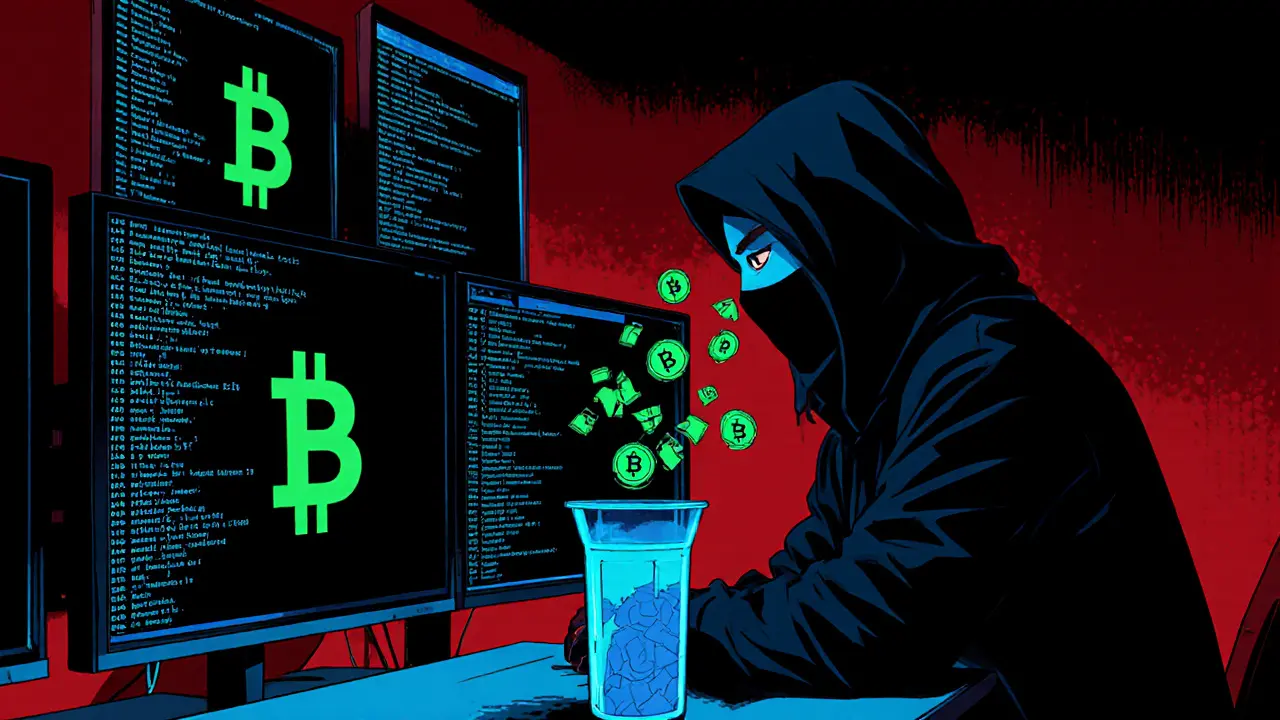North Korean Crypto Theft Impact Calculator
How Crypto Theft Funds North Korean Weapons
The U.S. Treasury estimates that every $1 million in illicit crypto stolen by North Korean actors supports approximately $4 million in missile program funding.
Based on the U.S. Treasury's estimate of 1:4 ratio between stolen crypto and missile program funding
When the U.S. Treasury’s OFAC (Office of Foreign Assets Control) announced a wave of designations in 2025, the headline was clear: North Korean crypto operations are now front‑and‑center of America’s sanctions enforcement.
Key Takeaways
- OFAC added six individuals and four front companies to its blacklist in August 2025.
- The designations focus on crypto‑theft, stablecoin laundering, and IT‑worker fraud schemes that fund DPRK weapons programs.
- Authorities seized millions in USDC, ETH, and high‑value NFTs linked to the networks.
- U.S. firms can reduce exposure by hardening KYC, monitoring blockchain addresses, and vetting remote workers.
- More designations are expected as investigators map the global facilitator ecosystem.
Why OFAC is Zeroing In on North Korean Crypto Networks
The Treasury’s Department of Treasury treats cryptocurrency as a “high‑risk, high‑reward” channel for sanctioned regimes. Since 2021, analysts at TRM Labs have tracked over $2.1 billion in crypto theft attributed to DPRK actors in the first half of 2025 alone. The sheer volume - plus the direct link to weapons‑of‑mass‑destruction funding - forced Washington to act decisively.
August 27 2025: The Biggest Designation Wave Yet
On August 27, OFAC announced six new listings:
| Date | Name / Entity | Role | Primary Activity |
|---|---|---|---|
| 2025‑08‑27 | Vitaliy Sergeyevich Andreyev | Russian national | Facilitated DPRK IT‑worker fraud |
| 2025‑08‑27 | Kim Ung Sun | North Korean operative | Converted crypto to cash for DPRK |
| 2025‑08‑27 | Shenyang Geumpungri Network Technology Co., Ltd | Front company | Laundered stablecoins via Chinese exchanges |
| 2025‑08‑27 | Korea Sinjin Trading Corporation | Front company | Managed offshore wallets for DPRK |
| 2025‑07‑08 | Kim Se Un | Individual | Oversaw crypto‑mining farm in Russia |
| 2025‑07‑24 | Jo Kyong Hun | Individual | Supplied counterfeit IDs for remote‑work fraud |
The designations marked a shift from targeting only the end‑point wallets to going after the full supply chain - from fake identity providers to the offshore exchange brokers that finally cash out the proceeds.

How the DPRK Crypto Networks Operate
At the heart of the operation are “IT‑worker” scams. Threat actors infiltrate U.S. crypto startups, pose as freelance developers on platforms such as GitHub, Freelancer, and RemoteHub, and then:
- Submit code or consulting services under a fabricated persona (e.g., “Joshua Palmer”).
- While on the job, harvest private keys, steal API tokens, or install back‑doors.
- Demand ransom in stablecoins (USDC, USDT) once the breach is discovered.
- Route the coins through a chain of mixers, split them across dozens of wallets, and finally convert to fiat via OTC brokers flagged in the 2024 sanctions.
Researchers have linked the same persona templates to multiple operations - a clear sign of a shared “playbook” managed by a central DPRK unit known as “Workers’ Party IT Cell”.
Financial Impact: From Crypto Theft to Missile Funding
TRM Labs’ on‑chain analysis shows that just three wallets associated with the August 2025 designations moved roughly $8.3 million in USDC and ETH within a month. The Department of Justice’s civil forfeiture complaint (June 5, 2025) seized over $7.7 million in crypto and NFTs tied to a separate laundering ring run by IT workers embedded in a U.S. Web3 firm.
These dollars don’t sit in a vault; they are funneled to senior DPRK officials - Kim Sang Man and Sim Hyon Sop - who allocate the cash to components for ballistic‑missile guidance systems. Open‑source intelligence (OSINT) estimates that every $1 million of illicit crypto supports roughly $4 million worth of missile parts, based on the regime’s historical conversion rates.
Enforcement Tools and International Cooperation
OFAC’s designations are backed by a whole‑of‑government effort:
- The FBI and Homeland Security Investigations seized wallets on the Vantage‑6 exchange.
- The Department of State coordinated joint statements with Japan and South Korea, urging tighter AML controls on crypto exchanges.
- Russian and UAE‑based hosting providers were pressured to shut down servers used for mixing services.
- Blockchain analytics firms (TRM Labs, Chainalysis) continue real‑time monitoring of flagged addresses.
These layers of pressure have already forced at least two previously used mixers to cease operations, reducing the “cover” DPRK actors once relied on.

Practical Steps for Companies to Shield Themselves
If you run a crypto‑related business, the sanctions mean you need a tighter security posture. Here’s a quick checklist:
- Strengthen KYC/AML: Require on‑chain address verification and screen all wallet recipients against the OFAC SDN list.
- Implement multi‑factor authentication for all developer accounts and enforce Git‑signed commits.
- Audit code repositories for unknown SSH keys or hard‑coded API secrets.
- Use reputable escrow services for large stablecoin payments; avoid direct wallet‑to‑wallet transfers with unknown parties.
- Run regular blockchain forensics on inbound funds to flag mixing patterns (e.g., rapid address hops, unusual transaction sizes).
- Train HR on the red‑flag signs of fraudulent remote‑work applications (reused email domains, mismatched IP geolocation).
Following these steps not only curbs exposure to DPRK sanctions but also bolsters overall cyber‑risk hygiene.
Looking Ahead: More Designations Likely
Analysts at the Department of Treasury project that the DPRK will double its crypto‑theft operations by 2026 as it refines automated phishing kits for the remote‑work market. That means OFAC will probably add more individuals and front companies in the coming months, especially from the Gulf and Southeast Asian regions where the regime has been expanding its logistical footprint.
For businesses, the message is clear: treat crypto not just as a financial asset but as a potential conduit for sanctioned activity. Continuous monitoring, robust identity verification, and quick response to OFAC updates are the new baseline for operating safely in the crypto space.
Frequently Asked Questions
What does it mean when OFAC sanctions a crypto address?
A sanctioned address is blocked from any U.S. person or entity doing business with it. Companies must freeze any assets linked to that address and report the holding to the Treasury.
Can I still trade USDC if it passes through a flagged wallet?
No. Even indirect exposure to a sanctioned wallet violates OFAC rules. You need to implement a transaction‑screening system that can detect and block such paths.
How do the IT‑worker fraud schemes differ from regular phishing?
Instead of a one‑off email trick, the DPRK actors embed themselves as actual employees, giving them ongoing access to codebases and internal data, and they blend legitimate work with theft.
What are the penalties for violating OFAC crypto sanctions?
Violations can result in civil fines up to $1 million per transaction, criminal penalties of up to $10 million, and possible imprisonment for responsible individuals.
Where can I find the latest OFAC designation list?
The Treasury publishes updates on its official website under the “Sanctions Programs and Country Information” section. Subscribe to the RSS feed for real‑time alerts.


16 Responses
The shift toward targeting entire supply chains really highlights how deep the problem runs.
The OFAC designations represent a decisive pivot in how sanctions are applied to the crypto ecosystem. By targeting not only end‑point wallets but also the ancillary service providers, the Treasury is effectively dismantling the logistical backbone of North Korean illicit finance. This approach forces illicit actors to either relocate their operations to jurisdictions with weaker regulatory oversight or to innovate entirely new anonymisation techniques. Either outcome increases the operational risk for those networks and raises the cost of conducting cyber‑enabled theft. Moreover, the public nature of the designations serves as a deterrent signal to other state‑sponsored actors who may have been contemplating similar schemes. The inclusion of front companies based in China and the United Arab Emirates illustrates the transnational nature of the problem. It also underscores the necessity for international cooperation, something that the article rightly highlights with its mention of joint statements from Japan and South Korea. The seizure of millions in USDC, ETH, and high‑value NFTs demonstrates that blockchain forensics have matured to a point where anonymity can be pierced, at least partially. Companies that ignore these developments risk not only regulatory penalties but also reputational damage should they be found facilitating sanctioned transactions. From a compliance perspective, the checklist provided is a solid starting point, but many firms still lack the automated tooling to screen on‑chain activity in real‑time. Integrating blockchain analytics APIs into existing AML platforms can bridge that gap, allowing suspicious address patterns to be flagged before funds move further. It is also prudent for firms to adopt multi‑factor authentication for all developer accounts, as the IT‑worker fraud schemes hinge on compromised credentials. The article's emphasis on training HR to spot bogus remote‑work applications cannot be overstated; social engineering remains a low‑cost, high‑reward vector for these actors. Looking ahead, the projected doubling of crypto‑theft operations by 2026 suggests that OFAC will likely expand its sanction list to include more facilitators in the Gulf and Southeast Asia. This escalation will place additional pressure on exchanges and custodians to tighten their own due‑diligence procedures. In sum, the current wave of sanctions is both a punitive measure and a catalyst for broader industry hardening against state‑sponsored crypto abuse.
Indeed, the comprehensive nature of these sanctions, which now encompass front companies, mixers, and even remote‑work facilitators, demonstrates a proactive stance; it also forces compliance teams to recalibrate their monitoring frameworks, to incorporate on‑chain analytics, and to engage with legal counsel more frequently than before.
It's encouraging to see the Treasury taking such a decisive step, and the crypto community can view this as a catalyst for stronger security standards across the board.
From a systems‑theory perspective, the network effect of these enforcement actions creates a negative feedback loop that raises the friction coefficient for illicit actors, effectively increasing the transaction cost of illicit crypto flows.
One practical tip is to integrate address screening directly into your wallet software so that transactions to flagged accounts are blocked automatically.
Compliance teams should also maintain up‑to‑date watchlists to ensure no sanctioned addresses slip through.
The sanction regime, while ostensibly about national security, also serves as a veil for deeper geopolitical maneuvers, and it raises the unsettling question of whose interests are truly being protected, as global financial controls can be weaponized against dissenting economies, a reality that must not be ignored.
Not every crypto transaction involving a North Korean wallet is malicious; blanket bans can inadvertently harm legitimate users.
Let's be clear, the DPRK's crypto theft operation is nothing short of a war on the global financial system, and anyone who downplays its impact is willfully blind.
We can all contribute by sharing best practices and staying vigilant, which ultimately strengthens the entire ecosystem.
These designations underscore the urgent need for the industry to adopt real‑time blockchain monitoring as a core component of risk management.
Implementing such monitoring not only meets regulatory expectations but also builds trust with partners and customers alike.
In conclusion, adherence to the outlined security measures will significantly reduce exposure to sanctioned activities.
It would be remiss to ignore the comprehensive scope of the Treasury's latest sanctions, which demand immediate institutional response and rigorous enforcement protocols.
Wow, another wave of sanctions-just what the crypto world needed, right? 🙄🔥